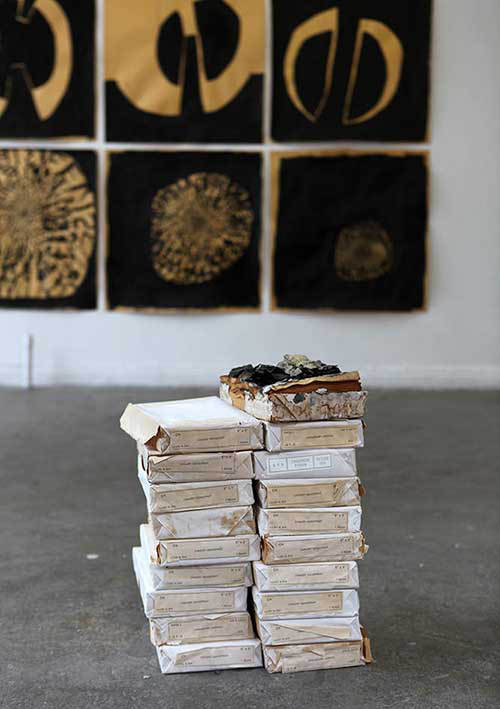 |
| Anastasia Ax, view of Swallowed Fear, 2014. Image: Anastasia Ax. |
Anastasia Ax does not shy away from the visceral, using her hands and body to construct raw images, sculptures, sound and performative pieces. The Stockholm-based artist’s medium is ink and paper, but she provokes one to rethink how they can serve as charged mediums, and she has a history of collaborating with experimental artists such as Lars Siltberg (in the case of this exhibition, Siltberg and Ax opened with a performance) and Marja-Leena Sillanpää. She often adopts the role of curious detective or archaeologist, searching or hunting for that which does not obviously prevail in the world as it appears to most. Ax’s work possesses an archival quality; she catalogues, collects and sifts through debris, the remnants and remainders of her creative journey. The works that make up her exhibitions are like relics from a broken era.
In this exhibition, Ax appears interested in the delicate boundary between nature and society, the works on show suggesting that these spheres aren’t in accord–that chaos and ferality inevitably reign despite attempts to rein them in. The show consists of posters and brittle, paper-based sculptures that insinuate both the constructive energy and dark side of change since the artist fixates on transformations that are simultaneously progressive and destructive; these works ask one to contemplate how mankind’s narrative has been documented for centuries using simila fibres and to reconsider the direction we are going, together and individually. In the press release, Ax insinuates the fact that these same fibres are derived from plants; our history has often been inscribed using such natural materials. Society, plants and paper likewise deteriorate and decompose, leaving room for new constructions inspired and fuelled by recycled energies. Additionally, the half-century-old paper Ax chooses to use is symbolic of humanity’s intellectual culture–fragile, deteriorating, layered. On the gallery floor sit two sculptures emphasising the violent, unpredictable quality of existence. Curled paper bubbles up–charred, crumpled and sitting atop piles of creamy paper, as if tainted by a now-silenced war zone or catastrophe. The unsaid, muted and masked motivate Ax’s feverish spectacles, which tend to be wordless and cryptic.
The poetic images in the posters portray moments during which culture moves towards and merges with nature. Each of them seems to be a window into what went awry at a given point in history (eg, images focus on apocalyptic, shock-and-awe moments: blackened cityscapes, intricate vortices), yet it is difficult to decipher what particular points in history the works refer to. It is this ambiguity which makes Ax’s work alluring: as if presenting once-buried hieroglyphics intended to represent the downfall of any culture from any era, she creates a constrained language. She forces an alternative communication, provoking the imagination with a unique array of codes, symbols and scenarios that can be widely interpreted. Like filmic stills that relay neither the climax nor denouement, these illustrations nevertheless convey Ax’s fragmented narrative of unexpected pivotal moments. Images of hands, eyes and off-kilter visages exist alongside circular objects and words (e.g. ’void’) engulfed in black ink. The power of each displayed image is magnified by the choice to minimise language, constraining any message via the usage of ink and paper.
To see the review in context, click here.








